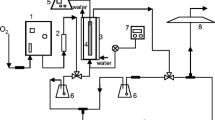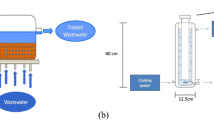Abstract
With the objective of reaching suitable techniques for olive mill wastewater treatment, ozonation and ultrafiltration were studied individually and combined. A continuous reactor was run for the treatment of a phenolic mixture mimicking an actual olive mill wastewater (OMW) by ozonation. The effect of the main operating parameters was analysed (pH, liquid flow rate and ozone inlet concentration). The increase of pH and ozone dose improved ozonation efficiency. As expected, the highest residence time led to higher steady-state degradation (35 % of chemical oxygen demand (COD) abatement). Even if the rise on ozone inlet gas concentration was able to remove COD in a higher extent, it should be taken into consideration that with the lowest oxidant load (15 g O3/m3), the maximum steady-state biochemical oxygen demand (BOD5)/COD ratio was reached which would reduce the process costs. These operating conditions (pH 9, 1 mL/min of liquid flow rate and 15 g O3/m3) were applied to an actual OMW leading to 80 % of phenolic content abatement and 12 % of COD removal at the steady state. Regarding ultrafiltration, it was concluded that the best total phenolic content (TPh) and COD abatement results (55 and 15 %) are attained for pH 9 and using a transmembrane pressure drop of 1 bar. Among the integration schemes that were tested, ultrafiltration followed by ozonation was able to reach 93 and 20 % of TPh and COD depletion, respectively. Moreover, this sequence led to an effluent with a BOD5/COD ratio of about 0.55 which means that it likely can be posteriorly refined in a municipal wastewater treatment plant.









Similar content being viewed by others
References
Akdemir E, Ozer A (2009) Investigation of two ultrafiltration membranes for treatment of olive mil wastewater. Desalination 249:660–665
Cañizares P, Lobato J, Paz R, Rodrigo MA, Sáez C (2007) Advanced oxidation processes for the treatment of olive-oil mills wastewater. Chemosphere 67:832–838
Cassano A, Conidi C, Drioli E (2011) Comparison of the performance of UF membranes in olive mill wastewaters treatment. Water Res 45:3197–3204
Cassano A, Conidi C, Giorno L, Drioli E (2013) Fractionation of olive mill wastewaters by membrane separation techniques. J Hazard Mater 248–249:185–193
Davies LC, Novais JM, Martins-Dias S (2004) Detoxification of olive mill wastewater using superabsorbent polymers. Environ Technol 25:89–100
Drouiche M, Mignot V, Lounici V, Belhocine D, Grib H, Pauss A, Mameri N (2004) A compact process for the treatment of olive mill wastewater by combining OF and UV/H2O2 techniques. Desalination 169:81–88
El-Abassi A, Khayet M, Hafidi A (2011) Micellar enhanced ultrafiltration process for the treatment of olive mill wastewater. Water Res 45:4522–4530
El-Abassi A, Kiai H, Raiti J, Hafidi A (2014) Application of ultrafiltration for olive processing wastewaters. J Clean Prod 65:432–438
El-Shafey EI, Correia PFM, Carvalho JMR (2005) An integrated process of olive mill wastewater treatment. Sep Sci Technol 40:2841–2869
Greenberg A, Clesceri L, Eaton A (1985) Standard methods for the examination of water and wastewater. American Public Health Association, Washington DC
Karageorgos P, Coz A, Charalabaki M, Kalogerakis N, Xekoukoulotakis N, Mantzavinos D (2006) Ozonation of weathered olive mill wastewaters. J Chem Technol Biotechnol 81:1570–1576
Maldonado MI, Malato S, Pérez-Estrada LA, Gernjak W, Oller I, Doménech X, Peral J (2006) Partial degradation of five pesticides and an industrial pollutant by ozonation in a pilot-plant scale reactor. J Hazard Mater 138:363–369
Mantzavinos D, Psillakis E (2004) Enhancement of biodegradability of industrial wastewater by chemical oxidation pre-treatment. J Chem Technol Biotechnol 79:431–454
Martins R, Quinta-Ferreira R (2009) Catalytic ozonation of phenolic acids over a Mn-Ce-O catalyts. Appl Catal B 90:268–277
Martins R, Quinta-Ferreira R (2011) Phenolic wastewaters depuration and biodegradability enhancement by ozone over active catalysts. Desalination 270:90–97
Martins RC, Silva AMT, Castro-Silva S, Garção-Nunes P, Quinta-Ferreira RM (2010) Adopting strategies to improve the efficiency of ozonation in the treatment of olive mill wastewaters. Environ Technol 31:1459–1469
Peña M, Coca M, González G (2007) Continuous ozonation of biologically pretreated molasses fermentation effluents. J Environ Sci Health A 42:777–783
Restivo J, Órfão JJM, Armenise S, Garcia-Bordejé E, Pereira MFR (2012) Catalytic ozonation of metolachlor under continuous operation using nanocarbon materials grown on a ceramic monolith. J Hazard Mater 239:249–256
Rodríguez A, Muñoz I, Perdigón-Melón JA, Carbajo JB, Martínez MJ, Fernández-Alba A, García-Calvo E, Rosal R (2012) Environmental optimization of continuous flow ozonation for urban wastewater reclamation. Sci Total Environ 437:68–75
Soares OS, Órfão JJM, Portela D, Vieira A, Pereira MFR (2006) Ozonation of textile effluents and dye solutions under continuous operation: influence of operating parameters. J Hazard Mater 137:1664–1673
Soares OS, Faria P, Órfão JJM, Pereira MFR (2007) Ozonation of textile effluents and dye solutions in the presence of activated carbon under continuous operation. Sep Sci Technol 42:1477–1492
Stoller M, Bravi M (2010) Critical flux analyses on differently pretreated olive vegetation waste water streams: some case studies. Desalination 250:578–582
Turano E, Curcio S, De Paola M, Calabrò V, Iorio G (2002) An integrated centrifugation-Ultrafiltration system in the treatment of olive mill wastewater. J Membr Sci 209:519–531
Yahiaoiu O, Lounici H, Abdi N, Drouiche N, Ghaffour N, Pauss A, Mamer N (2011) Treatment of olive mill wastewater by the combination of ultrafiltration and bipolar electrochemical reactor processes. Chem Eng Process 50:37–41
Acknowledgments
The authors thank Fundação para a Ciência e Tecnologia by the financial support under the contract (PTDC/EQU-ERQ/113308/2009). Rui C. Martins gratefully acknowledges Fundação para a Ciência e Tecnologia for the IFCT contract (IF/00215/2014).
Author information
Authors and Affiliations
Corresponding author
Additional information
Responsible editor: Bingcai Pan
Electronic supplementary material
Below is the link to the electronic supplementary material.
Fig. S1
(DOCX 30 kb)
Rights and permissions
About this article
Cite this article
Martins, R.C., Ferreira, A.M., Gando-Ferreira, L.M. et al. Ozonation and ultrafiltration for the treatment of olive mill wastewaters: effect of key operating conditions and integration schemes. Environ Sci Pollut Res 22, 15587–15597 (2015). https://doi.org/10.1007/s11356-015-4766-2
Received:
Accepted:
Published:
Issue Date:
DOI: https://doi.org/10.1007/s11356-015-4766-2




